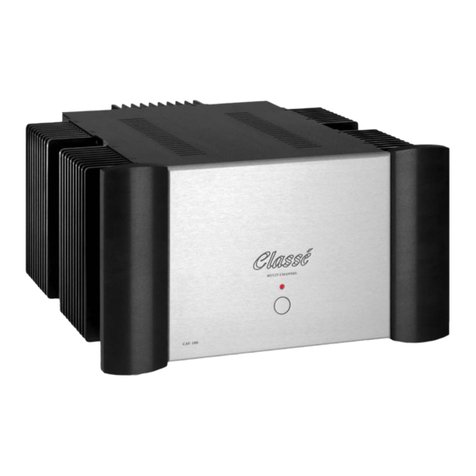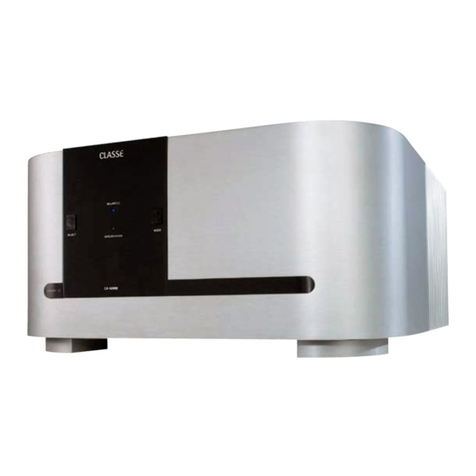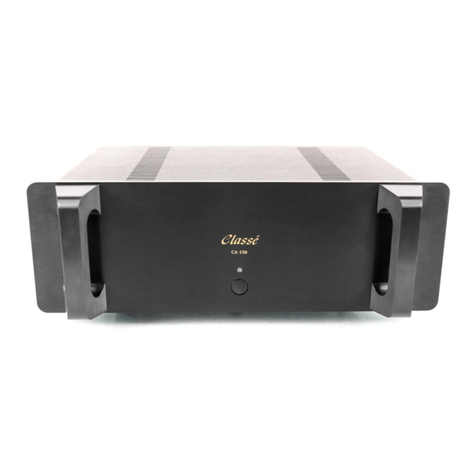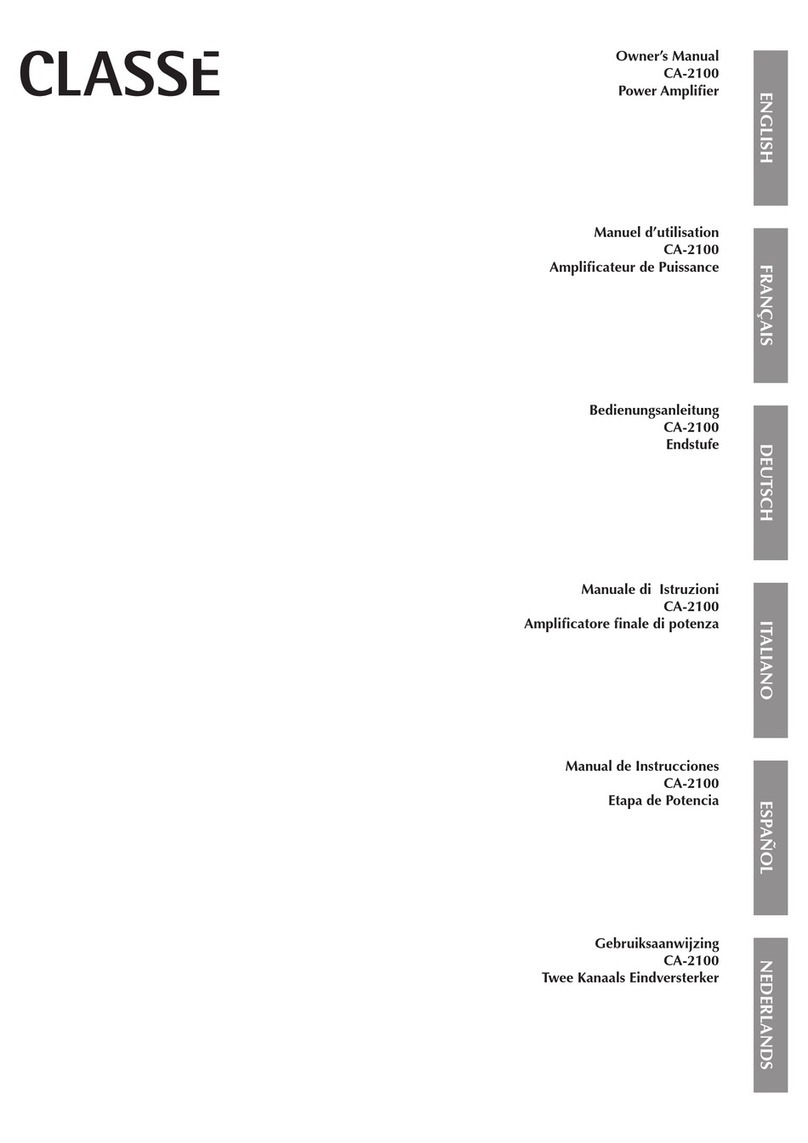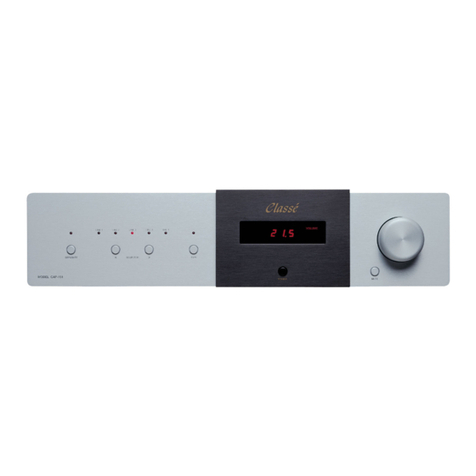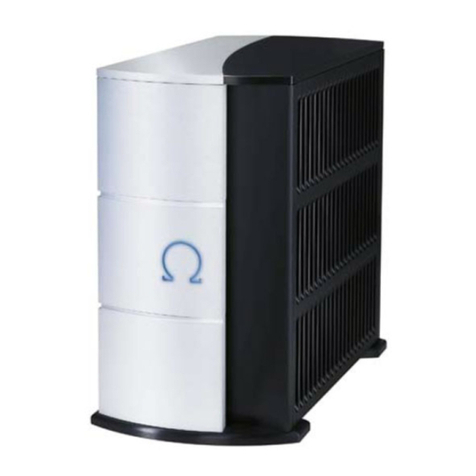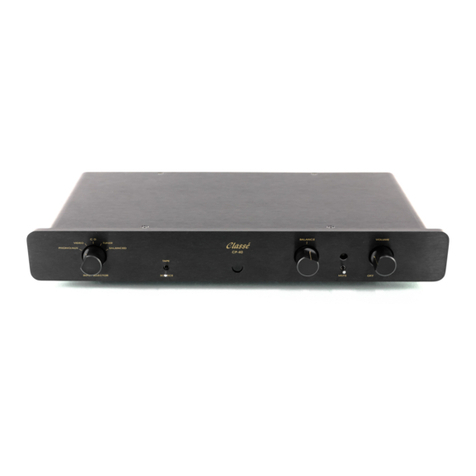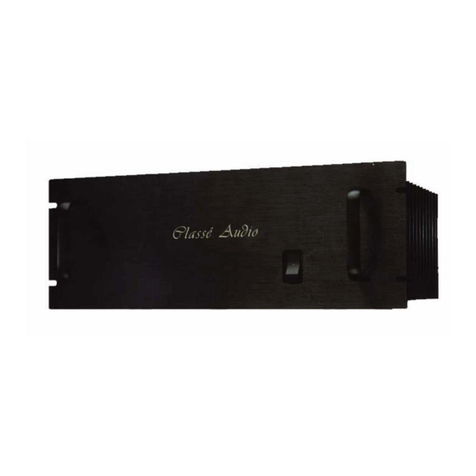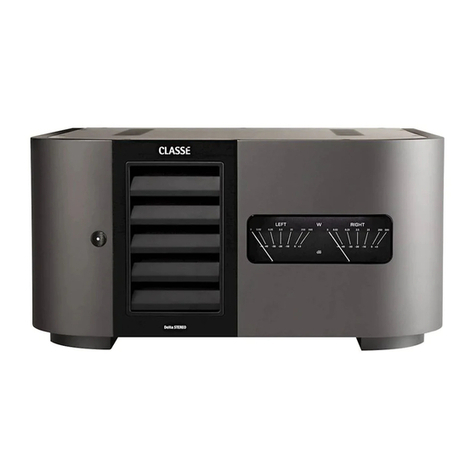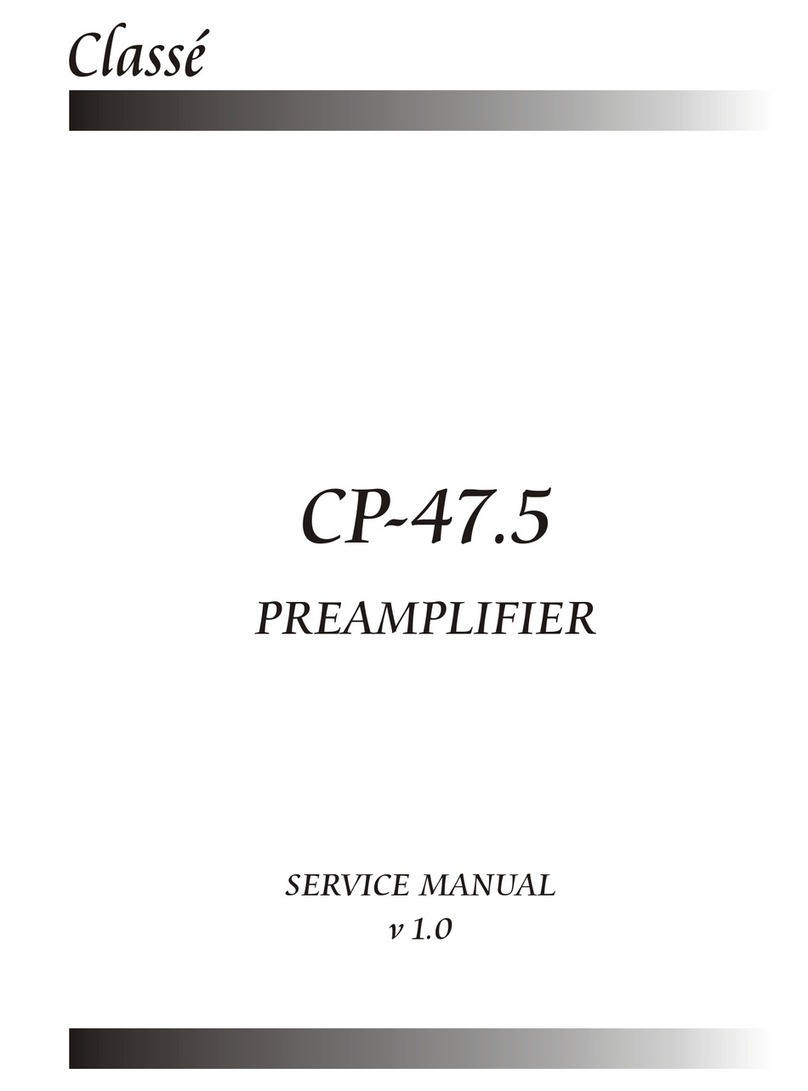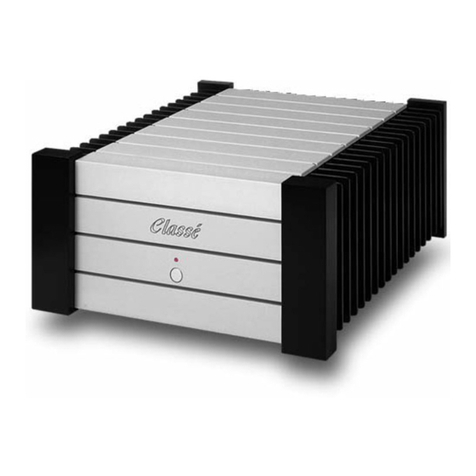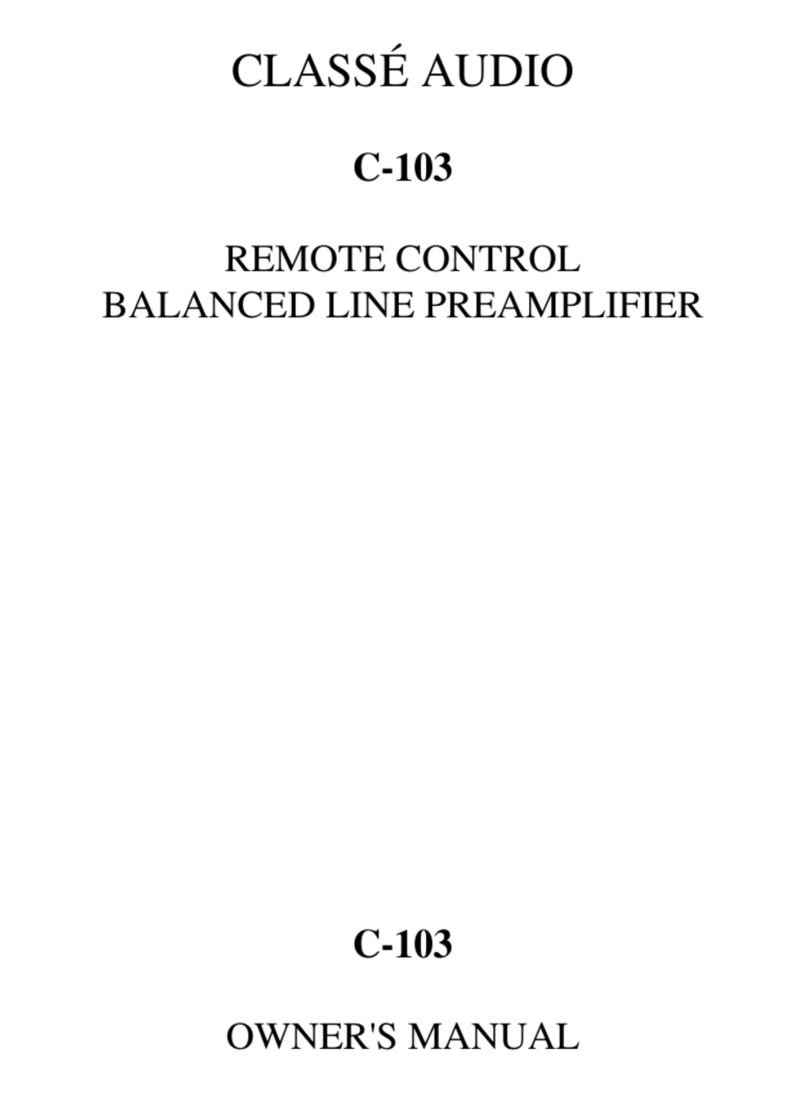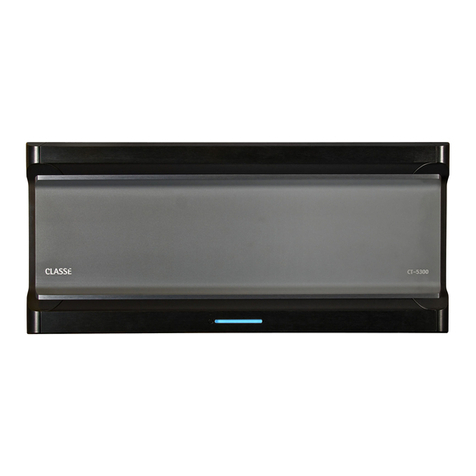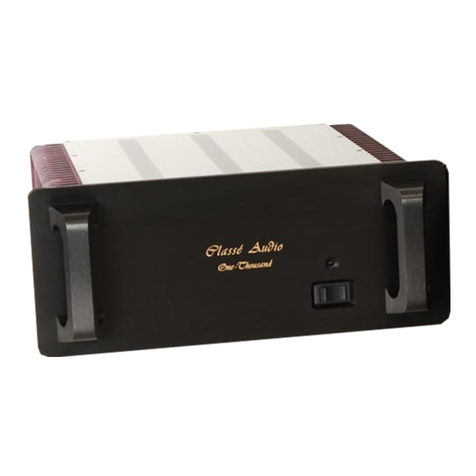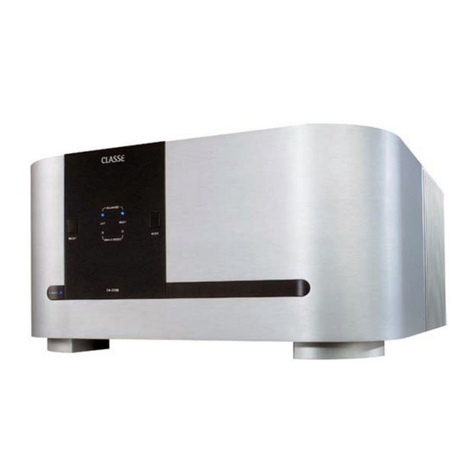
From an objective point of view, anyone
with the right equipment can measure noise.
So making the claim that the SMPS Classé has
designed for the CP-800 is our quietest power
supply ever is not a matter of opinion. It is fact.
While those familiar with other SMPS designs
will expect noise, simply put, they will nd it
startlingly absent here.
Power factor Correction
Power supplies have an enormous in uence
on the performance of audio circuits, but it is
not generally well understood that the cleanli-
ness and stability of the supplied power is only
part of the story. The power supply itself can
distort the AC mains in ways that can compro-
mise the performance of other audio compo-
nents on the grid.
Ideally, power would be pulled from the wall
in a smoothly ef cient manner. For maximum
ef ciency, the current demands should ow
exactly in phase with the voltage cycle. Since
power is the product of voltage and current,
it is easier (more ef cient) to pull power from
the wall by aligning current demands with the
available voltage cycle.
If the current demands are not in phase with
the voltage cycle, ef ciency is lost. From an
audio perspective, the power supply can clip or
distort the AC mains, which are usually shared
by other components. Fig.1 shows the mains
voltage and current being drawn by a surround
processor using both linear and switch mode
power supplies. Like all other components with
non-Power-Factor-Corrected power supplies,
it gulps current for short periods of each voltage
cycle. These gulps of current occur over
a relatively short time within the cycle (called
a narrow conduction angle), meaning the peak
current demand is higher than it would be if
drawn over the full cycle, and the waveform
itself contains higher frequencies and their
harmonics. The higher current peaks and their
high frequency harmonics degrade the quality
of power available to other system components.
This is a problem for both linear and switch
mode power supplies (both of which are used
in the example). They draw current from the
wall in large gulps rather than smoothly fol-
lowing the cycle of voltage. The solution to
Zero Volt Switching
By using the fairly new concept of Zero Volt
Switching (ZVS), the Classé SMPS was devel-
oped to have a low noise, small RF footprint—
a requirement for the highest quality audio
rendering. The main bene ts of ZVS, re ned
by the Classé Design team during an extensive
R&D phase, are:
• The Primary Switch used in the design is
switched when the supply voltage is at a
minimum, thus greatly minimizing a ‘hard
switching’ effect which contributes to high
levels of unwanted EMI.
• EMI performance is further improved by not
adhering to a xed switching methodology.
By instead employing a ‘valley switching’
methodology, a spread-spectrum component
further reduces EMI spectra. Instead
of artifacts being concentrated around
a single frequency, they are distributed at
lower amplitude across a wider spectrum.
• ZVS promotes higher ef ciency of the
DC-DC converter sub-system, ensuring
optimised ef ciency of the power supply.
Four Supplies in One
The CP-800 SMPS provides four separate
outputs. Techniques to capitalize on the new
power supply’s low output impedance and
perfect cross-regulation (matching for plus
and minus rails) provide a very low AC imped-
ance at local regulator input pins for optimal
performance. The outputs of all local regulators
are conditioned to have low impedance at high
audio frequencies to effectively reject noise.
USB circuitry is powered from its own galvani-
cally isolated +5 V output, ensuring unwanted
noise cannot couple into the CP-800 audio cir-
cuits from USB-connected devices. An added
bene t of this power supply design is that
fully isolated USB devices including the iPad®
(which requires a whopping 2.1 amps to charge
at full power) may charge while connected to
and playing through the CP-800.
The engineering feat to develop an audio-
friendly SMPS is considerable. The Classé
R&D focus has been to identify the key technol-
ogies and thoroughly understand how to take
advantage of all the possible advantages while
preventing or controlling unwanted side-effects.
When a transistor is on, it delivers power with
almost no resistive loss and when it is off, it’s
an open circuit so it draws no power. These
characteristics make the switcher greater than
90% ef cient. The switching occurs at a very
high frequency which, in addition to enabling
the use of smaller component parts, allows the
supply to remain perfectly stiff regardless of the
load or the uctuations on the AC line.
So what’s the catch? Why don’t high-end audio
designers use Switch Mode Power Supplies?
The most common explanation they give is
that an SMPS inherently generates ultra-sonic
artifacts and spurious signals. In some applica-
tions these don’t present a problem but they
can seriously degrade both the perceived and
measured audio quality. Further, an electrical
engineering student could design a passable
linear power supply, but SMPS designs are
considerably more sophisticated and apply
a broader range of technology. It is this techno-
logical development applied to high-end audio
which has been lacking and has now been
addressed by the Classé Design team. Only
a team who understands both the SMPS
technology and the requirements of high-end
analog and digital audio circuitry can produce
a design that effectively deals with any gener-
ated noise while capitalizing on all of the inher-
ent bene ts of the topology.
The power supply rejection ratio of a linear pow-
er supply is determined by looking for an output
signal at the same frequency as the signal being
injected into the supply. Said another way, the
rejection ratio compares the signal you want to
amplify in the circuit to the amount of that signal
that is re ected back into the circuit through the
power supply. With SMPS, the audio signals do
not re ect back into the circuit but rather interact
with the switching frequency of the supply to
create intermodulation artifacts. For example,
if the switching frequency is 140 kHz and the
test signal is 1 kHz, intermodulation components
may show up as 139 kHz and 141 kHz signals.
These signals and their harmonics, if not dealt
with, can show up as unwanted ultrasonic noise
that ‘pours’ into the audio circuitry where it will
couple into devices, generating unwanted au-
dible artifacts. The Classé SMPS was designed
to avoid this problem.
